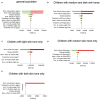Cost-Effectiveness of Vitamin D Supplementation in Pregnant Woman and Young Children in Preventing Rickets: A Modeling Study
- PMID: 33014962
- PMCID: PMC7498641
- DOI: 10.3389/fpubh.2020.00439
Cost-Effectiveness of Vitamin D Supplementation in Pregnant Woman and Young Children in Preventing Rickets: A Modeling Study
Abstract
Background: Literature on the cost of management of rickets and cost-effectiveness of vitamin D supplementation in preventing rickets is lacking. Methods: This study considered the cost-effectiveness of providing free vitamin D supplementation to pregnant women and children <4 years of age with varying degrees of skin pigmentation to prevent rickets in children. Estimates for the prevalence of rickets were calculated using all cases of rickets diagnosed in Central Manchester, UK and census data from the region. Cost of management of rickets were calculated using National Health Service, UK tariffs. The efficacy of vitamin D supplementation was based on a similar programme implemented in Birmingham. Quality of life was assessed using utility estimates derived from a systematic literature review. In this analysis the intervention was considered cost-effective if the incremental cost-effectiveness ratio (ICER) is below the National Institute for Health and Care Excellence, UK cost-effectiveness threshold of £20,000 per Quality-adjusted life year (QALY). Results: Fifty-seven patients (26 dark, 29 medium and 2 light skin tones) were managed for rickets and associated complications over 4-years. Rickets has an estimated annual incidence of 29·75 per 100,000 children <4 years of age. In the dark skin tone population vitamin D supplementation proved to be cost saving. In a medium skin tone population and light skin tone populations the ICER was £19,295 per QALY and £404,047 per QALY, respectively. Conclusion: Our study demonstrates that a vitamin D supplementation to prevent rickets is cost effective in dark and medium skin tone populations.
Keywords: cost-effectiveness; decision tree model; incremental cost-effectiveness ratio; prevention; quality adjusted life years; rickets.
Copyright © 2020 Floreskul, Juma, Daniel, Zamir, Rawdin, Stevenson, Mughal and Padidela.
Figures



Similar articles
-
Is vitamin D supplementation program in Iranian schools effective in reducing adolescent depressive symptoms? Cost effectiveness study.BMC Public Health. 2023 Jul 20;23(1):1393. doi: 10.1186/s12889-023-16244-z. BMC Public Health. 2023. PMID: 37474906 Free PMC article.
-
The cost-effectiveness analysis of a nationwide vitamin D supplementation program among Iranian adolescents for adulthood cardiovascular diseases prevention.Public Health. 2021 Sep;198:340-347. doi: 10.1016/j.puhe.2021.07.019. Epub 2021 Sep 9. Public Health. 2021. PMID: 34509859
-
Prevalence of classic signs and symptoms of rickets and vitamin D deficiency in Mongolian children and women.J Steroid Biochem Mol Biol. 2013 Jul;136:207-10. doi: 10.1016/j.jsbmb.2012.10.014. Epub 2012 Nov 2. J Steroid Biochem Mol Biol. 2013. PMID: 23123493 Review.
-
Incidence and characteristics of vitamin D deficiency rickets in New Zealand children: a New Zealand Paediatric Surveillance Unit study.Aust N Z J Public Health. 2015 Aug;39(4):380-3. doi: 10.1111/1753-6405.12390. Epub 2015 Jun 29. Aust N Z J Public Health. 2015. PMID: 26122859
-
[Deficiency rickets: the current situation in France and Algeria].Pediatrie. 1989;44(4):259-64. Pediatrie. 1989. PMID: 2677969 Review. French.
Cited by
-
Price Dispersion of Vitamin D Supplements Over Time: An Initiative for Prescriber Education.Indian J Endocrinol Metab. 2021 Mar-Apr;25(2):142-147. doi: 10.4103/ijem.ijem_159_21. Epub 2021 Sep 8. Indian J Endocrinol Metab. 2021. PMID: 34660243 Free PMC article.
-
Economic evaluation of a national vitamin D supplementation program among Iranian adolescents for the prevention of adulthood type 2 diabetes mellitus.BMC Complement Med Ther. 2022 Jan 3;22(1):1. doi: 10.1186/s12906-021-03474-0. BMC Complement Med Ther. 2022. PMID: 34980092 Free PMC article.
-
Vitamin D testing in children and adolescents in Victoria, Australia: are testing practices in line with global recommendations?Arch Dis Child. 2023 Sep;108(9):742-747. doi: 10.1136/archdischild-2022-325000. Epub 2023 May 17. Arch Dis Child. 2023. PMID: 37197895 Free PMC article.
-
Barriers to adequate nutrition care for child malnutrition in a low-resource setting: Perspectives of health care providers.Front Public Health. 2023 Mar 9;11:1064837. doi: 10.3389/fpubh.2023.1064837. eCollection 2023. Front Public Health. 2023. PMID: 36969677 Free PMC article.
References
-
- SACN vitamin D and health report Scientific Advisory Committee on Nutrition (SACN) and Public Health England. (2016). Available online at: https://www.gov.uk/government/publications/sacn-vitamin-d-and-health-report (accessed August 21, 2020).
-
- Farrar MD, Webb AR, Kift R, Durkin MT, Allan D, Herbert A, et al. . Efficacy of a dose range of simulated sunlight exposures in raising vitamin D status in South Asian adults: implications for targeted guidance on sun exposure. Am J Clin Nutr. (2013) 97:1210–6. 10.3945/ajcn.112.052639 - DOI - PubMed
Publication types
MeSH terms
Substances
LinkOut - more resources
Full Text Sources
Medical

